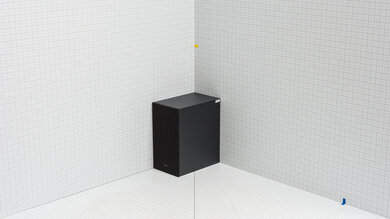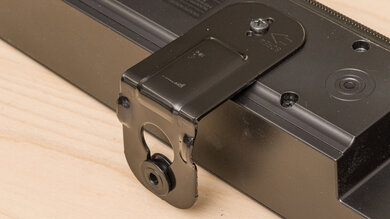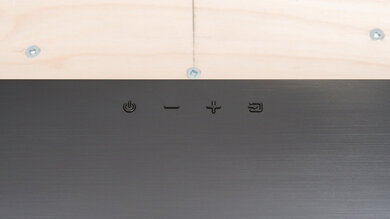The Samsung HW-B550 is a 2.1 soundbar released in 2022. It's the next generation of the Samsung HW-A550 and performs quite similarly to its predecessor. It's a simple bar that's best for listening to stereo content, which includes most music and TV shows. If you want to improve its surrounds performance, you can add a Wireless Rear Speaker Kit, which is sold separately. However, there's no Dolby Atmos support to let you take advantage of more immersive formats on streaming platforms. You don't get access to Samsung's more premium features, like room correction, which optimizes audio to your room's unique acoustics, and Q-Symphony, which pairs the bar with compatible Samsung TVs for an enhanced sound.
Our Verdict
The Samsung B550 is decent for mixed usage. As a 2.1 soundbar, it's ideal for listening to stereo content, which encompasses most music and dialogue-heavy TV shows. Out-of-the-box, its neutral sound ensures voices and lead instruments reproduce with clarity, and you have lots of customization tools to change up its sound. You don't feel as much rumble in the bass as with more premium models, especially with bass-heavy music and movies. 5.1 surround sound formats like Dolby Digital, which you find on lots of streaming platforms, aren't very immersive-sounding, either.
-
Graphic EQ and presets.
-
Bass and treble adjustments.
-
Lacks some low-bass.
-
No satellites included.
The Samsung B550 is very good for dialogue-focused TV shows and podcasts. With its balanced mid-range, voices reproduce with clarity and detail. You even have a dialogue enhancement mode (Voice Enhance) as well as a night-mode feature that balances out the volume between different programs and commercials. Without a discrete center channel, dialogue isn't quite as clear or real as with 3.0 setups, but it still does a good job overall.
-
Dialogue enhancement feature.
-
Bluetooth support.
-
No support for Apple AirPlay, Wi-Fi, or Chromecast.
The Samsung B550 is very good for music. Out-of-the-box, it has a balanced sound, with neutral mids that ensure voices and lead instruments reproduce accurately. As a result, it's suitable for listening to most music genres. It gets loud, and you have many customization tools on hand to make it sound the way you want. That said, there's a noticeable lack of bass on certain tracks, especially bass-heavy genres like EDM and hip-hop.
-
Graphic EQ and presets.
-
Bass and treble adjustments.
-
Lacks some low-bass.
The Samsung B550 is fair for movies. Dialogue reproduces with clarity and accuracy, and you have plenty of enhancement tools to customize its sound. However, you don't feel the deep thump in the low bass during intense movie scores or action-packed scenes. You can't take advantage of more immersive object-based formats like Dolby Atmos, which you find on lots of streaming platforms. 5.1 surround sound formats like Dolby Digital are downmixed into stereo, which doesn't sound very immersive. However, you can always add a rear speaker kit if you want to improve its surround sound.
-
Graphic EQ and presets.
-
Dialogue enhancement feature.
-
Lacks some low-bass.
-
No satellites included.
- 7.3 Mixed Usage
- 7.8 Dialogue/TV Shows
- 7.8 Music
- 6.7 Movies
Changelog
-
Updated Jan 14, 2025:
The Compared To Other Soundbars and Surround 5.1 boxes have been updated to mention the Samsung HW-B750D.
- Updated Jun 04, 2024: Updated text in Stereo Dynamics, Audio Latency: ARC, Audio Latency: HDMI In, and Audio Latency: Optical boxes with new methodology from TBU 1.3. Some updates to the usages as well.
- Updated Jun 03, 2024: We've converted this review to Test Bench Update 1.3. If applicable, we've retested stereo sound based on the manufacturer's recommendations. Additionally, we've expanded our audio latency tests to the following boxes: Audio Latency: ARC, Audio Latency: HDMI In, and Audio Latency: Optical. You can see the full changelog here.
- Updated Jun 07, 2023: Converted to Test Bench 1.2. Updated the results for audio format support via ARC/eARC, HDMI In, and Optical. Added Video Passthrough to TV results as well.
- Updated Mar 08, 2023: Added cable lengths to In The Box.
Differences Between Sizes And Variants
The Samsung B550 is available in 'Black'. You can see the label for the model we tested here.
If you come across another version, let us know in the discussions, and we'll update our review.
Compared To Other Soundbars
The Samsung B550 is a simple 2.1 bar that offers nearly identical performance to its 2021 predecessor, the Samsung HW-A550. Designed for stereo content like music and TV shows, it does a good job with those formats, though, as expected, it's not ideal for 5.1 surround sound. There are some extra features compared to the more budget-friendly Samsung HW-B450, also released in 2022, like a graphic EQ and HDMI connections. But, given the similarity of their frequency responses, it might not be worth the extra cost. Still, if you watch a lot of surround sound content, the 2024 Samsung HW-B750D offers an improved surround performance with a 5.1 setup in an otherwise very similar package.
See also our recommendations for the best soundbars, the best Samsung soundbars, and the best soundbars for dialogue.
The Samsung HW-B650 is better than the Samsung HW-B550. They're both similar bars with similar sounds right out of the box and lots of customization tools on hand. However, the B650 adds a discrete center, which improves vocal clarity. The B550 remains a good option for those looking for a more budget-friendly choice.
The Samsung HW-B550 is better than the Samsung HW-B450. They're both 2.1 soundbars that offer similar stereo frequency responses, but the B550 comes with some extra features. It's better built and has a graphic EQ, so you have more ability to customize its sound. There are also HDMI connections, which the B450 lacks. If you aren't interested in these features, though, the B450 is pretty similar, and it's more affordable overall.
The Samsung HW-Q600A is better than the Samsung HW-B550. The Q600A is a 3.1.2 bar, and unlike the 2.1 B550, it supports Dolby Atmos content. It also comes with a discrete center channel, so vocals are reproduced more clearly in the mix.
Since the Samsung HW-B550 comes with a subwoofer, it can reproduce more bass than the standalone Sonos Arc. That said, the Sonos shines in other regards. Its stereo soundstage is better, as is its surround sound performance. It can playback height content like Dolby Atmos, unlike the Samsung soundbar. You can always add a sub on to the Sonos to improve its bass performance, too.
The Samsung HW-B550 is the next generation of the Samsung HW-A550. That said, they offer almost identical performances. They're both 2.1 bars with lots of customization tools, including a 7-band graphic EQ. With neutral frequency responses out-of-the-box, they're suitable for listening to most types of audio content, though they lack a little punch in the bass that's noticeable with bass-heavy music and movies. Neither support Atmos content.
The Samsung HW-B550 is better than the Polk Audio Signa S2. They're both budget-friendly 2.1 bars, but the Samsung soundbar performs best. It has more sound enhancement features, like a graphic EQ that lets you customize its sound to your liking. It's better-built, too, with a more balanced sound out-of-the-box than the boomy Polk.
The Samsung HW-B550 and the Samsung HW-A650 offer similar frequency responses, so you don't notice much of a difference between their sound. However, the A650 is a 3.1 setup with a discrete center, which improves vocal clarity in your audio. Given the price difference, though, this may not be worth the value for some listeners.
Depending on your listening habits, you may prefer either the Vizio V Series V21-H8 or the Samsung HW-B550. They're both 2.1 bars at budget-friendly prices. The Vizio is best for fans of bass-heavy music—it reproduces more low-bass and adds more boom and punch to the mix right out of the box. The Samsung is more balanced out-of-the-box but has more customization tools, like a graphic EQ. You can add more boom in the high-bass with these features, but unfortunately, the Samsung soundbar still doesn't get the rumble in the low-bass like the Vizio.
Test Results
The Samsung B550 has a similar design to last year's Samsung HW-A550. It's mostly made of plastic, and there's a metal grille covering the front and sides. It's very lightweight, too. However, compared to last year's model, the sides have an angled design that makes it stand out.
While no satellites are included, you can add a Wireless Rear Speaker Kit from the manufacturer separately.
The sub is roughly the same size as what you get with the Samsung HW-A550. It's equivalent to an average desktop computer, and it connects to the bar wirelessly for more flexibility when you add it to your living room.
The Samsung B550 has a great build quality. The bar itself is mostly made of solid, lightweight plastic, and the metal grille on the front and sides helps protect the drivers inside better than the fabric sides of the Samsung HW-B450. The sub is the weaker part of the design, though, as the fabric feels thin. It collects dust easily, too.
The Samsung B550 has a great stereo frequency response. It performs similarly to the Samsung HW-B450, as it sounds neutral right out-of-the-box, especially in the mids, where more voices and lead instruments reproduce. It's suitable for most music genres as a result, and dialogue in TV shows is clear and crisp. The subwoofer is controlled, but you notice the absence of low-bass with certain tracks, especially bass-heavy genres like EDM and hip-hop.
The Samsung B550 comes with lots of sound enhancement features to help you get the best sound for your needs. If you prefer a more neutral response, it's best to use its default settings.
The Samsung B550 has a decent stereo soundstage. The soundstage is perceived to be about as wide as the bar itself, but it doesn't have any tricks to make it seem larger than that. It has good focus, though, especially compared to other 2.1 bars we've tested. As a result, sounds like instruments in an orchestral recording seem to come from accurate locations in the soundstage.
The Samsung B550 has excellent stereo dynamics. It gets loud enough to fill most living rooms with sound. There's a little compression when you push it to max volume, especially in the bass and treble ranges, but it's not too noticeable, so audio quality isn't degraded at loud volumes.
The Samsung B550 has an okay center channel performance. Since it's a 2.1 bar, it uses its left and right stereo speakers to simulate a phantom center channel. As a result, voices aren't quite as accurately localized as they are in bars with a discrete center channel. While its frequency response is a little bass-heavy, voices are still pretty clearly reproduced, and you don't have any issues understanding dialogue. If you want a similar bar with a discrete center, check out the Samsung HW-B650.
The Samsung B550 has a poor surrounds performance, typical of 2.1 bars. It has to downmix 5.1 surround sound formats like Dolby Digital and DTS into stereo to play them, which doesn't sound quite as immersive. Sound effects don't seem as clear and real in the soundstage—instead, it seems like they're just coming from a speaker placed in front of you. Even if you don't want to splurge for satellites (or lack the room for them), its successor, the Samsung HW-B750D, has a 5.1 configuration, so it won't downmix content to stereo.
The Samsung B550 has a decent selection of sound enhancement features. You don't have room correction like with more premium bars in the manufacturer's lineup, so it sounds a little different depending on your room's acoustics. Fortunately, you have lots of ability to customize its sound using its bass and treble adjustments and its graphic EQ. If you don't want to play around with the sound too much, there are also some preset modes: 'Standard', 'Surround Sound', 'Bass Boost', 'Game', and 'Adaptive Sound Lite'. The settings button on the remote gives you access to other tools like Night Mode, Voice Enhance, and the Audio Sync feature to reduce latency. If you choose to add on a Wireless Rear Speaker Kit, you can adjust its levels.
The Samsung B550 has more inputs than the Samsung HW-B450. You can connect it to your TV using Optical or HDMI, and both cables are included with the bar, which is handy.
Via HDMI ARC, the Samsung B550 supports Dolby Digital, which is the most commonly-used surround sound format that's often found on streaming platforms. There's DTS support, too, which is great if you watch a lot of Blu-rays. It doesn't support lossless or object-based formats like Dolby Atmos, though.
The Samsung B550 supports Dolby Digital and DTS via Full HDMI In. It's helpful since Dolby Digital is the most common surround sound format, and you're likely to come across it on different streaming platforms. Often, DTS is a fallback for higher-quality DTS-HD MA formats found on many Blu-rays.
The Samsung B550 supports both DTS and Dolby Digital content via Optical. Since it's a 2.1 bar, it has to downmix it into stereo to play it.
This bar has an excellent latency performance via ARC. Although this connection supports limited formats, your audio and visuals stay in sync regardless of which format you select. Some apps and TVs compensate for latency, though.
The Samsung B550 also has excellent latency performance via HDMI In. It has fairly low latency between both supported formats, ensuring that your audio and visuals are in sync. It's worth mentioning that certain TVs and apps compensate for the delay differently, so your experience can vary.
The latency performance via Optical is decent. Compared to HDMI In and ARC, latency is high, regardless of whether you're playing 2.0 PCM or Dolby Digital content, so you may notice lip-syncing errors. Some apps and TVs can compensate for latency, though.
The Samsung B550 lets you wirelessly stream audio from your mobile devices to the bar over Bluetooth.
Comments
Samsung HW-B550: Main Discussion
Let us know why you want us to review the product here, or encourage others to vote for this product.
Update: The Compared To Other Soundbars and Surround 5.1 boxes have been updated to mention the Samsung HW-B750D.




































